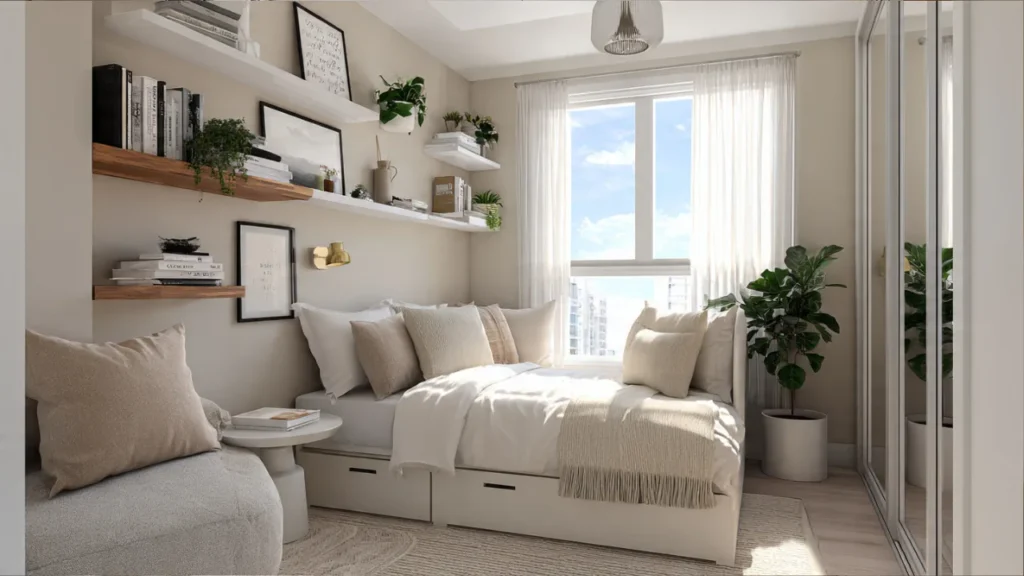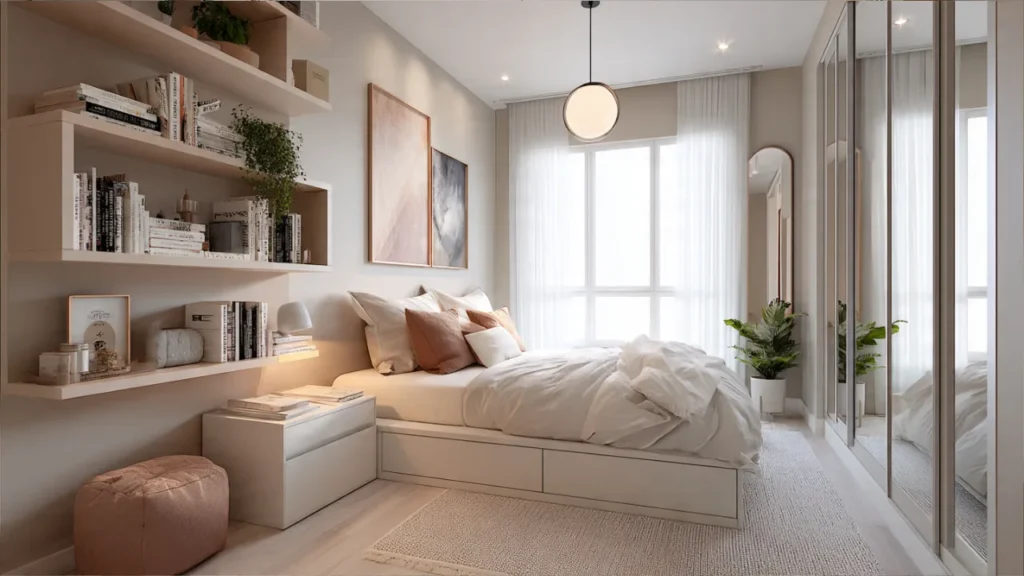Creating a beautiful and functional small bedroom can feel challenging, but with the right interior design approach and smart wardrobe solutions, even the tiniest space can become a stylish sanctuary.

This comprehensive guide explores modern design strategies that maximize space while maintaining aesthetic appeal.
Understanding Small Bedroom Design Challenges
Small bedrooms require thoughtful planning to balance storage needs, comfort, and visual appeal. The key is making every square foot count while avoiding a cramped feeling. Modern design principles focus on creating illusion of space through strategic furniture placement, color choices, and multifunctional pieces.
Choosing the Right Wardrobe for Small Bedrooms
Built-In Wardrobes
Built-in wardrobes are ideal for small bedrooms because they utilize every inch of available wall space. These custom solutions can fit into awkward corners or alcoves that standard furniture cannot accommodate. Floor-to-ceiling designs maximize vertical storage while maintaining a streamlined appearance.
Sliding Door Wardrobes
Sliding door wardrobes save significant space compared to traditional hinged doors. They require no clearance for door swing, making them perfect for tight spaces.

Modern sliding wardrobes come in mirrored finishes that reflect light and create depth, making rooms appear larger.
Freestanding Wardrobes
For renters or those wanting flexibility, freestanding wardrobes offer portability. Choose slim profile designs with heights that draw the eye upward. Light-colored finishes help these pieces blend seamlessly with walls rather than dominating the space.
Color Schemes That Expand Visual Space
Light and Neutral Palettes
White, cream, beige, and light gray create airy atmospheres in small bedrooms. These colors reflect natural light effectively, making spaces feel more open. Monochromatic schemes with varying shades of one color add depth without visual clutter.
Strategic Accent Colors
While maintaining light base colors, incorporate accent colors through textiles, artwork, or a single accent wall. Soft blues, greens, or blush pinks add personality without overwhelming the space. Keep bold colors to small doses for maximum impact.
Smart Storage Solutions Beyond Wardrobes
Under-Bed Storage
Utilize the space beneath your bed with storage drawers or bins. Platform beds with built-in storage compartments eliminate need for additional furniture.

This hidden storage keeps seasonal items or extra bedding organized and out of sight.
Vertical Storage
Install floating shelves above the bed or desk area for books, plants, and decorative items. Wall-mounted organizers and hooks maximize vertical space while keeping floors clear. Tall, narrow bookcases use minimal floor space while providing substantial storage.
Multi-Functional Furniture
Ottoman beds with storage compartments serve dual purposes. Nightstands with drawers replace bulky dressers. Wall-mounted desks fold away when not needed, creating flexibility in room usage.
Lighting Strategies for Small Bedrooms
Layered Lighting Approach
Combine ambient, task, and accent lighting to create depth and functionality. Overhead fixtures provide general illumination, while bedside lamps offer reading light. LED strip lighting under shelves or behind headboards adds modern ambiance.
Maximizing Natural Light
Keep window treatments minimal to allow maximum natural light penetration. Sheer curtains provide privacy while maintaining brightness. Position mirrors opposite windows to bounce light throughout the room.
Space-Saving Light Fixtures
Wall-mounted sconces free up nightstand space while providing necessary lighting. Pendant lights hanging from the ceiling eliminate need for floor or table lamps. Recessed lighting maintains clean ceiling lines in modern designs.
Furniture Layout Tips for Small Bedrooms
Bed Placement
Position the bed against the longest wall to maximize floor space. In very small rooms, consider placing the bed in a corner to free up circulation space. Ensure at least 24 inches of walking space around the bed for comfortable movement.
Creating Zones
Define sleeping, dressing, and work zones even in compact spaces. Use area rugs to visually separate areas without physical barriers. Consistent color schemes unite zones while maintaining distinct functions.
Scale Appropriate Furniture
Choose furniture proportional to room size. Oversized pieces overwhelm small spaces, while appropriately scaled items maintain balance. Consider apartment-sized furniture specifically designed for compact living.
Modern Wardrobe Design Features
Interior Organization Systems
Modern wardrobes incorporate adjustable shelving, pull-out drawers, and specialized compartments for shoes, accessories, and folded items. Customizable systems adapt to changing storage needs over time.
Smart Technology Integration
Contemporary wardrobes may include LED motion-sensor lighting, charging stations for devices, and even climate control features for delicate garments. These technological additions enhance functionality without requiring additional space.
Sustainable Materials
Eco-friendly wardrobes crafted from reclaimed wood, bamboo, or recycled materials align with modern sustainable living values. These choices often feature clean lines and natural finishes that complement minimalist design aesthetics.
Decorating Small Bedrooms with Style
Minimalist Approach
Embrace minimalism by keeping only essential items visible. Clean surfaces and organized storage create calm, spacious feelings. Quality over quantity applies to both furniture and decorative elements.
Texture and Pattern
Add visual interest through varied textures rather than multiple colors. Knit throws, linen bedding, and woven baskets create depth. Use patterns sparingly—perhaps one patterned element like wallpaper or bedding as a focal point.
Personal Touches
Display meaningful items that reflect personality without cluttering surfaces. A gallery wall of photos or art adds character while using vertical space efficiently. Rotate decorative items seasonally to keep the space feeling fresh.
Maintaining Organization in Small Spaces
Regular Decluttering
Small bedrooms require consistent organization to prevent overwhelming clutter. Implement the “one in, one out” rule when acquiring new items. Seasonal clothing rotation keeps wardrobes manageable year-round.
Storage Solutions
Use matching boxes, baskets, and containers to create visual cohesion while organizing small items. Label storage containers for quick identification. Drawer dividers keep clothing and accessories neatly separated.
Daily Habits
Make the bed each morning to instantly improve room appearance. Return items to designated spots after use. Spend five minutes each evening tidying to maintain organization effortlessly.
Budget-Friendly Small Bedroom Updates
DIY Projects
Paint existing furniture for fresh looks without replacement costs. Create custom storage solutions using affordable materials from hardware stores. Install peel-and-stick wallpaper for temporary design changes.
Shopping Smart
Browse secondhand stores and online marketplaces for quality furniture at reduced prices. Wait for sales at major retailers for bedding and accessories. Invest in key pieces like quality mattresses while economizing on decorative items.
Phased Renovations
Transform your bedroom gradually rather than all at once. Start with paint and lighting, then add furniture and accessories over time. This approach spreads costs while allowing design evolution.
Small Bedroom Design Mistakes to Avoid
Oversized Furniture
Avoid large, bulky furniture that dominates floor space. Choose streamlined pieces with exposed legs that create visual lightness. Scale matters more in small rooms than in spacious ones.
Dark Color Overload
While dark accent walls can work, covering entire small rooms in dark colors makes them feel cramped. Reserve bold, dark hues for accessories or single statement elements.
Neglecting Vertical Space
Failing to utilize wall height wastes valuable storage potential. Install shelves, hooks, and tall storage units to maximize every dimension of the room.
Too Many Decorative Items
Excessive accessories create visual chaos in confined spaces. Curate collections carefully, displaying only favorite pieces. Rotate decorative items to prevent stagnation without overwhelming the space.
Conclusion
Designing a modern small bedroom with an efficient wardrobe system requires creativity, planning, and strategic choices. By implementing space-saving furniture, thoughtful color schemes, and smart storage solutions, you can create a bedroom that feels spacious, organized, and personally meaningful.
The key to success lies in maximizing functionality without sacrificing style. Whether you’re working with a built-in wardrobe system or optimizing a freestanding piece, modern design principles help small bedrooms reach their full potential. Remember that less is often more in compact spaces—focus on quality pieces, maintain organization, and allow your personality to shine through thoughtful design choices.
With these strategies, your small bedroom can become a restful retreat that proves size doesn’t limit style or comfort. Start with one area, perhaps your wardrobe organization, and gradually implement changes that transform your space into the modern, functional bedroom you’ve always wanted.
